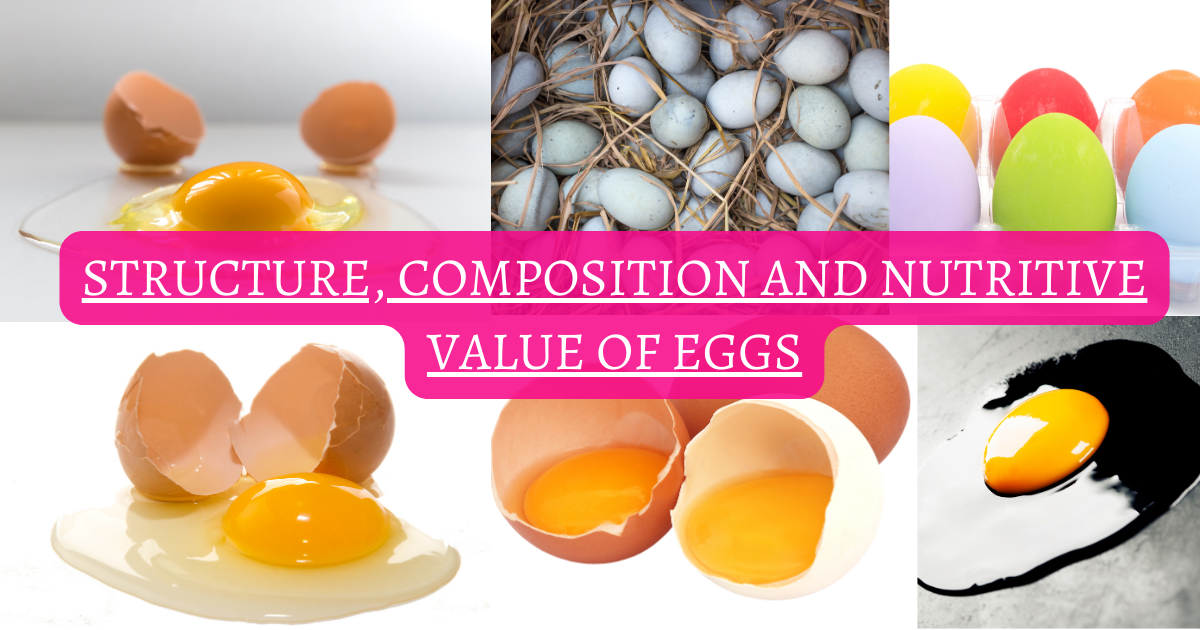Structure, Composition and Nutritive Value of Eggs
An acquaintance with the formation and structure of eggs is necessary to effectively preserve it’s quality during storage and marketing. The egg is basically nature’s device to produce a chick. So, it has the necessary infrastructure for the production and nutritional requirements of developing embryos and newly hatched chick.
There are four main components of hen’s egg:
- Shell
- Shell membranes
- Albumen or white
- Yolk
The yolk develops in the functional left ovary of the hen as an ovum largely during the final 10 days before release. After ovulation or release, fully developed ovum or yolk is engulfed in the oviduct where a gel of albumin or egg white is secreted to surround the yolk for a few hours. Finally, the shell membranes and the calcareous shell are deposited in the oviduct for nearly 16 hours before the egg is laid.
Structure
i. Shell: The outer protective covering of an egg is shell, which comprises around 11% of its total weight. It is mainly composed of calcium carbonate. The shell contains numerous minute pores on the entire surface, which are partially sealed by keratin. These pores allow loss of carbon dioxide and moisture from the eggs. However, a few of them (hardly 12-20) may permit bacterial penetration within the egg under specific circumstances. Thus shell structure consists of three basic units:
- Outer cuticle made up of keratin
- Middle spongy or calcareous layer
- Inner mammary layer.
ii. Shell membranes: The shell is attached to the shell membranes. The outer thick and inner thin membranes are usually inseparable except at the broad end of the egg forming an air cell. The shell membranes are a part of in-built defence mechanism in the egg because of their role as an effective barrier against bacterial invasion. The air cell continues to increase in size during storage due to loss of moisture and shrinkage of egg contents.
iii. Albumen: The white or albumen portion of egg constitutes about 58% of the total weight of an egg. It occurs in four layers as follows:
- Outer thin layer
- Outer thick layer
- Inner thin layer
- Inner thick white or chalaziferous layer.
The proportion of thin and thick white varies according to the breed and age of the hen. Thick content is comparatively more. The inner thick white layer surrounds the vitelline membrane of the yolk and its firm mucin like fibres continue as chalazae, which has the specific function of keeping the yolk in the centre.
iv. Yolk: The yolk constitutes nearly 31 of the total egg weight. It consists of the following four structures from outside:
- Vitelline membrane
- Concentric rings of light and dark yolk material
- Latebra (cone like portion extending to the centre of yolk)
- Germinal disc (located in the cone of latebra).
Chemical Composition
As mentioned earlier, an egg consists of 11% shell, 58& albumen and 31% yolk. The cuticle of egg shell is composed of a foaming layer of proteinaceous matter especially keratin, it covers the calcified portion of the shell which is made up of calcium carbonate (94%) with minor quantities of calcium phosphate (1%), magnesium carbonate (1%) and proteinaceous material especially keratin. The true cell membrane consists of protein fibres. The inner membrane is comparatively thick.

Egg albumen or white contains approximately 88% water. Most of the solid content is protein. Lipid content is virtually absent. However, very minute quantity of carbohydrate (0.5%) may be present. Albumen may be regarded as a protein system consisting of microscopic fibres in a solution of numerous globular proteins. Some important albumen proteins and their characteristics are presented in Table below:

Egg yolk contains more than 50% solids, which are mainly lipids (32%) and proteins (16%). Yolk lipid is composed of mostly triglyceride (65%), good amount of phospholipid (28%) and controversial cholesterol (5%). The ash content of yolk is about 1%. A little of carbohydrate, usually less than 0.5%, may also be present.
Nutritive Value
An egg contains about six grams of protein. Egg protein is of such a high quality that its biological value has been taken as 100 and it acts as a standard for evaluating the biological value of other food proteins. All the essential amino acids required in human diet are present in egg proteins. An egg also provides five to six grams of easily digestible fat, wherein the proportion of much desired unsaturated fatty acids (especially oleic acid) is more as compared to most other livestock products. Egg is an important source of fat-soluble vitamins (A, D, E and K) and water-soluble vitamins of B-complex group. However, it does not contain vitamin C.

With very little carbohydrates, egg has a remarkably low caloric value which justifies its inclusion in the food for people on restricted diet. Egg is very good source of important minerals such as iron, phosphorus, potassium and trace elements which are necessary for the formation of blood, bone and soft-tissues. Though cholesterol content of egg yolk is comparatively high, it is not likely to significantly influence the blood cholesterol level unless taken indiscriminately because cholesterol is found in blood, nerve tissues, and other parts of the human body as a normal constituent of the cell.
